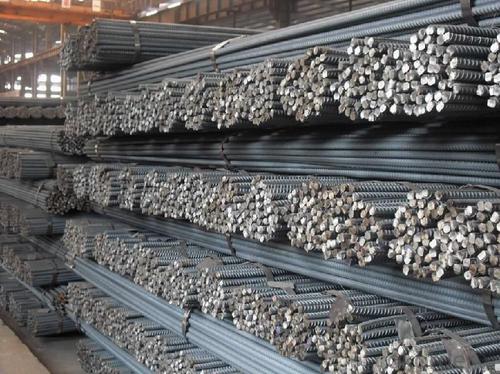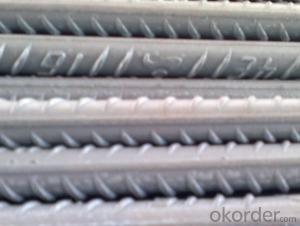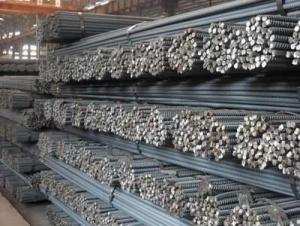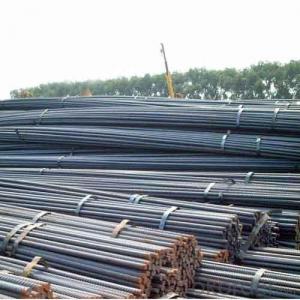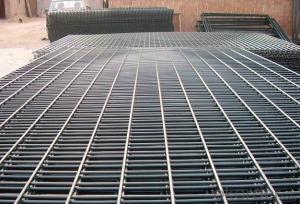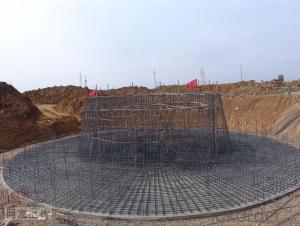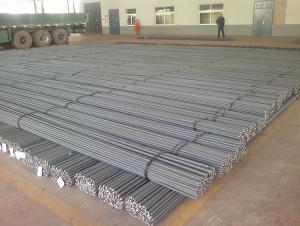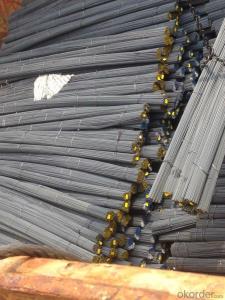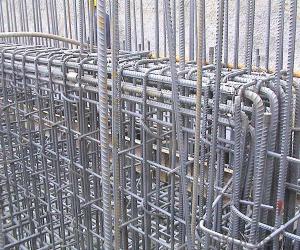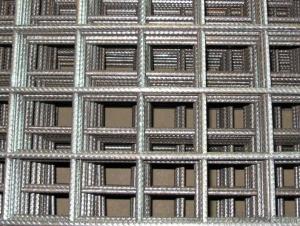Basic Mild Steel Deformed Bar
- Loading Port:
- China Main Port
- Payment Terms:
- TT OR LC
- Min Order Qty:
- -
- Supply Capability:
- -
OKorder Service Pledge
OKorder Financial Service
You Might Also Like
Usage and Applications of HRB400 Deformed Steel Bar:
Deformed bar is widely used in buildings, bridges, roads and other engineering construction. Big to highways, railways, bridges, culverts, tunnels, public facilities such as flood control, dam, small to housing construction, beam, column, wall and the foundation of the plate, deformed bar is an integral structure material. With the development of world economy and the vigorous development of infrastructure construction, real estate, the demand for deformed bar will be larger and larger..
Packaging & Delivery of HRB400 Deformed Steel Bar:
Packaging Detail: products are packed in bundle and then shipped by container or bulk vessel, deformed bar is usually naked strapping delivery, when storing, please pay attention to moisture proof. The performance of rust will produce adverse effect.
Each bundle weight: 2-3MT, or as required
Payment term: TT or L/C
Delivery Detail: within 45 days after received advanced payment or LC.
Label: to be specified by customer, generally, each bundle has 1-2 labels
Trade terms: FOB, CFR, CIF
Cold Rolled Techniques
Yield Point: 545-565mpa
Deformed bar is widely used in buildings, bridges, roads and other engineering construction. Big to highways, railways, bridges, culverts, tunnels, public facilities such as flood control, dam, small to housing construction, beam, column, wall and the foundation of the plate, deformed bar is an integral structure material. With the development of world economy and the vigorous development of infrastructure construction, real estate, the demand for deformed bar will be larger and larger.
- Q: Are steel rebars fire-resistant?
- Yes, steel rebars are generally considered to be fire-resistant. Due to their high melting point and low thermal conductivity, steel rebars can withstand high temperatures and maintain their structural integrity in the event of a fire. However, their fire resistance can be compromised if exposed to extremely high temperatures for extended periods of time.
- Q: What are the different methods of reinforcing concrete structures using steel rebars?
- There are several methods of reinforcing concrete structures using steel rebars. These include placing the rebars in a grid pattern to provide overall strength and support, using stirrups or ties to hold the rebars in place and prevent them from moving, using dowel bars to connect two separate concrete elements, and using anchor bolts or hooks to secure the rebars to the existing structure. Additionally, steel mesh or fiber reinforcement can be used to enhance the overall durability and resilience of the concrete structure.
- Q: How do steel rebars contribute to the overall sustainability of a project?
- Steel rebars contribute to the overall sustainability of a project in several ways. Firstly, steel rebars are highly durable and have a long lifespan, which means they do not need to be replaced frequently. This reduces the consumption of resources and minimizes the need for new material production, thereby decreasing the environmental impact of the project. Additionally, steel rebars are fully recyclable. At the end of their life cycle, they can be easily collected, melted down, and repurposed into new steel products. This recycling process significantly reduces the demand for raw materials, conserves energy, and decreases the amount of waste going to landfills. Furthermore, steel rebars provide structural strength and enhance the overall safety and resilience of the project. By reinforcing concrete structures, steel rebars help increase their load-bearing capacity and resistance to external forces, such as earthquakes or extreme weather events. This ensures the longevity and stability of the project, reducing the need for repairs or reconstruction in the future. Lastly, the use of steel rebars in construction projects often results in shorter construction time and lower maintenance costs. The ease of handling and installing steel rebars allows for efficient construction processes, leading to reduced energy consumption and lower greenhouse gas emissions. Moreover, the durability and low maintenance requirements of steel rebars minimize the need for ongoing repairs and replacements, resulting in cost savings over the project's lifespan. In conclusion, steel rebars contribute to the overall sustainability of a project by being durable, recyclable, and enhancing structural strength and safety. Their use reduces resource consumption, waste generation, and energy consumption, while also providing long-term cost savings. Incorporating steel rebars in construction projects is a sustainable choice that promotes environmental conservation, economic efficiency, and social resilience.
- Q: How do steel rebars affect the overall construction cost of industrial buildings?
- Steel rebars can have a significant impact on the overall construction cost of industrial buildings. Rebars are used as reinforcement in concrete structures, providing strength and durability. The amount of steel rebars required in a building project directly affects the cost, as the price of steel is a major component of the overall construction expenses. Firstly, the quantity of rebars needed depends on the size, design, and complexity of the industrial building. Larger buildings or those with intricate architectural features may require a higher number of rebars, resulting in increased costs. Additionally, the design and engineering requirements for seismic or wind resistance can also influence the quantity of rebars, further impacting the construction budget. Moreover, the quality and grade of the steel rebars used can affect the cost. Higher-grade rebars, such as those with higher tensile strength or corrosion resistance, may be more expensive. However, using higher-grade rebars can provide long-term benefits by enhancing the structural integrity of the building and reducing maintenance and repair costs over its lifespan. Transportation and handling costs also contribute to the overall cost. Steel rebars are heavy and bulky, requiring careful handling and transportation to the construction site. The distance between the steel supplier and the site can significantly impact transportation costs. Additionally, the storage and protection of rebars on-site must be considered to ensure their quality, which may involve additional expenses. Lastly, labor costs associated with the installation of steel rebars should be taken into account. Skilled labor is required to correctly place and tie the rebars according to design specifications and building codes. The complexity of the reinforcement design can affect the time required for installation, ultimately influencing labor costs. In conclusion, steel rebars play a vital role in the construction of industrial buildings by reinforcing concrete structures. The quantity, quality, transportation, and labor costs associated with steel rebars directly impact the overall construction cost. Therefore, careful planning and consideration of these factors are necessary to effectively manage the budget of industrial building projects.
- Q: How are steel rebars protected from corrosion in marine environments?
- Steel rebars are protected from corrosion in marine environments through the application of a protective coating, such as epoxy or zinc, or by using stainless steel rebars that have inherent resistance to corrosion. Additionally, concrete cover is provided to rebars to isolate them from direct contact with seawater, further enhancing their protection against corrosion.
- Q: What is the recommended minimum diameter of steel rebars used in earthquake-prone areas?
- The recommended minimum diameter of steel rebars used in earthquake-prone areas is typically 12 millimeters or larger.
- Q: How are steel rebars protected against galvanic corrosion?
- Steel rebars are protected against galvanic corrosion through the application of a protective coating, such as epoxy or zinc, that acts as a barrier between the rebar and the surrounding environment. Additionally, measures like proper concrete cover and adequate concrete quality can also help minimize the risk of galvanic corrosion in steel rebars.
- Q: What are the main properties of steel rebars?
- Steel rebars, also known as reinforcing bars, are essential components in reinforced concrete structures. They possess several key properties that make them ideal for providing strength and durability to these structures. 1. Strength: One of the primary properties of steel rebars is their high tensile strength. They can withstand significant pulling forces and provide the necessary reinforcement to resist cracking and structural failure in concrete. 2. Ductility: Steel rebars exhibit excellent ductility, meaning they can deform without fracturing under stress. This property allows them to absorb energy during seismic events or other extreme loads, enhancing the overall structural performance and resilience of the reinforced concrete. 3. Corrosion resistance: Steel rebars are typically manufactured with a protective layer, such as epoxy or galvanized coating, to prevent corrosion. This property is crucial as exposure to moisture, chloride ions, and other corrosive elements can significantly weaken the rebars and compromise the integrity of the structure. 4. Weldability: Steel rebars can be easily welded together, allowing for efficient and effective construction. This property ensures that rebars can be connected to form a continuous and robust reinforcement network, enhancing the overall strength and stability of the concrete structure. 5. Thermal compatibility: Steel rebars have similar thermal expansion and contraction properties to concrete, minimizing the risk of cracking or structural damage due to temperature changes. This compatibility ensures the long-term durability and stability of reinforced concrete structures. 6. Availability and cost-effectiveness: Steel rebars are widely available and relatively cost-effective compared to other reinforcing materials. This affordability, combined with their excellent mechanical properties, makes them a popular choice for structural reinforcement across various construction projects. In conclusion, the main properties of steel rebars include high tensile strength, ductility, corrosion resistance, weldability, thermal compatibility, and cost-effectiveness. These properties make steel rebars indispensable for providing structural strength and durability to reinforced concrete structures.
- Q: How do steel rebars resist seismic forces?
- Steel rebars resist seismic forces in several ways. Firstly, their high tensile strength allows them to withstand the intense forces generated during an earthquake. Additionally, rebars are embedded within concrete structures, providing reinforcement and increasing the overall strength and stability of the building. The ductility of steel rebars also plays a crucial role as they have the ability to deform and absorb energy during seismic events, which helps prevent sudden collapse. Overall, the combination of strength, reinforcement, and ductility makes steel rebars an effective solution for resisting seismic forces and ensuring the safety of structures during earthquakes.
- Q: Do steel rebars increase the overall weight of a structure?
- Indeed, the utilization of steel rebars does amplify the overall weight of a structure. Rebars are generally included to fortify concrete structures, offering tensile strength to counterbalance the concrete's vulnerability in managing tension forces. Steel rebars consist of steel, a material that is both dense and weighty. By incorporating rebars into a structure, the weight of these elements contributes to the entirety of the construction's weight. Nevertheless, the supplementary weight is typically insignificant when compared to the overall weight of the structure, especially in extensive ventures. The advantages of employing steel rebars in terms of structural integrity and longevity far surpass the minimal augmentation in weight they contribute.
Send your message to us
Basic Mild Steel Deformed Bar
- Loading Port:
- China Main Port
- Payment Terms:
- TT OR LC
- Min Order Qty:
- -
- Supply Capability:
- -
OKorder Service Pledge
OKorder Financial Service
Similar products
Hot products
Hot Searches
Related keywords

